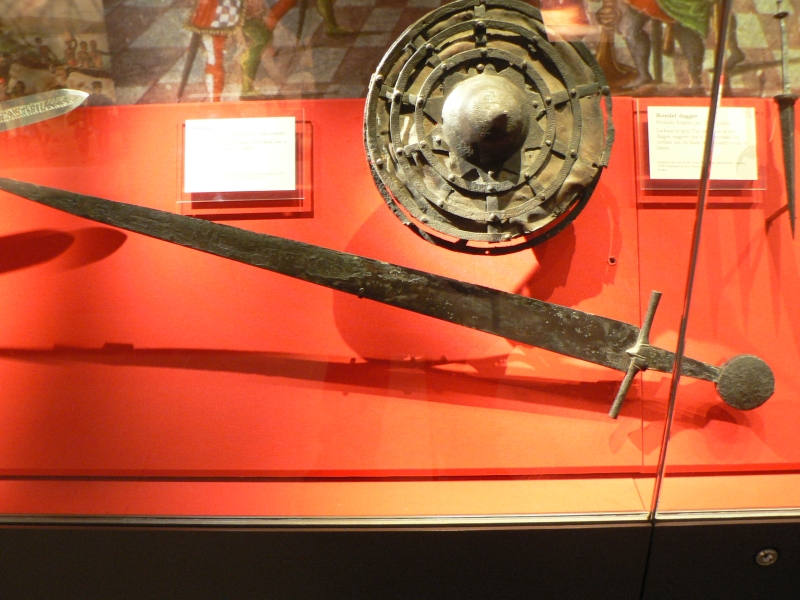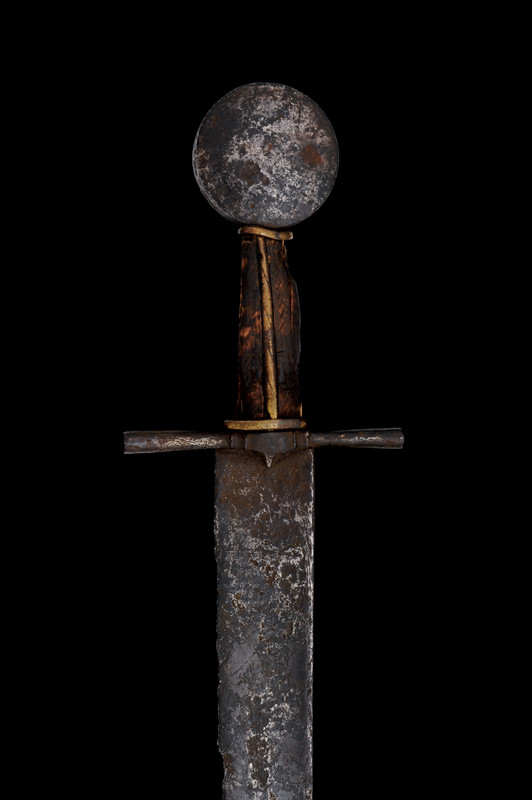I think these single-edged pointy swords were much more common than many give them credit for. The 'Louis de Bruges' copy of Froissarts chronicles and other coeval manuscripts show many of the archers carrying swords with the front quillon bent into a knuckle-bow and a square pommel. I personally believe that these are meant to represent swords of the "wakefield type" which are basically sword-length hammer-headed daggers. Also, many baselard/schweitzerdegen of sword length have single edged blades. The tendency of museums to display long impressive pieces that match the visitors expectations of what a medieval sword is probably leaves a lot of these gems in boxes in the back room and distorts our conception of the relative rarity or commoness of these types.
As a step toward some kind of agreed-upon terminology that we can use to discuss and describe these weapons, I will summerize my research into "straight(ish), single-edged, pointy short-swords of the 14th-15th c." Sorry, I don't have my references with me.
1- "wakefield type"- As far as I know, the name "wakefield" comes from the use of the name by MRL for their replica. The type specimen can be seen in the "hammer headed daggers" thread. It has a 60cm blade, a s-shaped guard forming a knuckle-bow with a nagel-like side-bar and a side-lugged pommel. Another example has a longer, less tapered but still sharp-pointed blade, a similar guard and a pommel shaped into a crude boar's head. A third example is similar to the second but all three terminals of the guard are shaped like cloven hooves. These latter two examlpes may represent a kind of proto-hanger while the first is more military, but due to the similarity in overall design, I suggest grouping them together. The archers swords in LdB Froissart's chronicles all have square pommels but I have yet to see an example.
2-"SE swords with hilts like double-edged swords."- self explanatory. Personally I think a lot of the apparently DE swords depicted in LdB are actually meant to represent these.
3-"SE basilards/schweitzerdegen"- I-shaped hilt with blades identical to those of previous types. Good example known from England c 1520.
I do not know how far back the term Backsword goes, but don't think I have ever heard it used in a 15th c context. However some of these swords and especially the wakefield type certainly have characteristics that foreshadow later developements in
English swords. Aside from the blade form, the nagel-like side-bar is similar to those found in early transitional basket-hilts. There seems to be a rather straight-forward evolution from wakefield type (1450-1510) to transitional backswords with quillons, seperate knuckle-bow and single side bar (1520-1530) to early basket-hilt backsword. Calling them some sort of falchion doesn't seem quite right. In german I would call them Rauf-degen (brawling degen) Degen meaning a usually SE thrusting short-sword. I recently saw a raufdegen on herman historica? that had a short single-edged thrusting blade, quillons, seperate knuckle-bow , side rings and a asymetrical pommel. Functionally identical to a wakefield, but in the german style. These weapons were considered to be an alternative to a katzbalger( notice cat-fighter vs brawling stabber.) Incidentally, There are some wakefield types illustrated in some of the german art shown in the "extremely long daggers" thread.
| Quote: |
Hope that was coherent enough. I am a bit sleep deprived. When I learn how to use this computer contraption I'll post some pictures. Any thoughts? |






